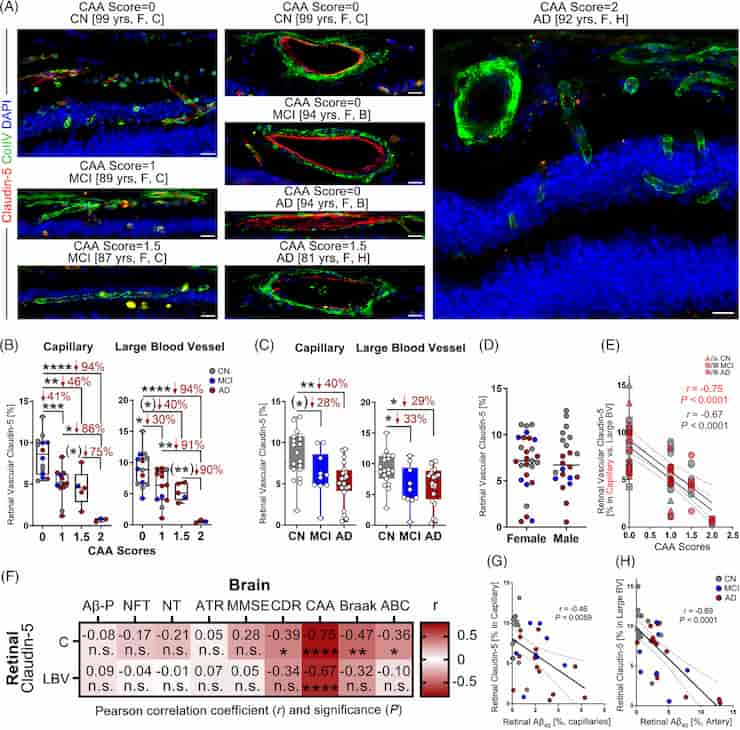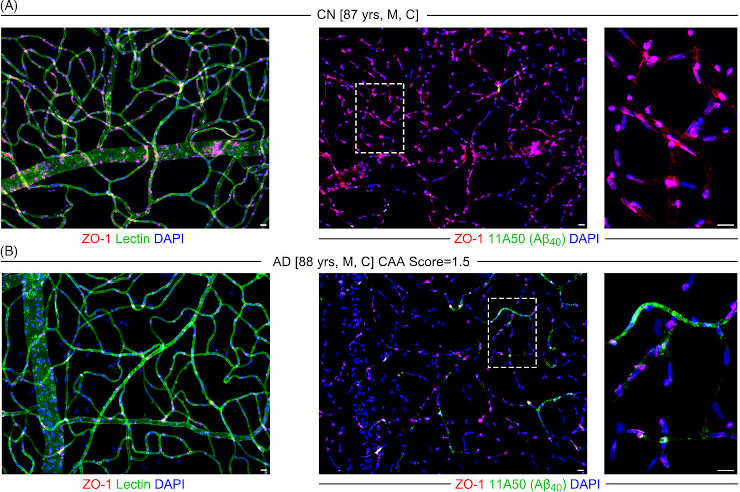Blood vessel abnormalities in the eye are a significant factor in the progression of Alzheimer’s disease, according to research conducted by researchers at Cedars-Sinai Medical Center. These alterations correspond to alterations in the brain, highlighting a new opportunity for early diagnosis.
The study sheds new light on the vascular changes associated with Alzheimer’s disease, particularly in the retina, the nerve tissue layer at the back of the eye.
Researchers compared the blood vessels in the retinas of 24 Alzheimer’s disease patients, 10 patients with mild cognitive impairment, and 27 patients with normal cognition.

Credit: Alzheimer’s Dement. 2023; 1- 13 CC-BY
Blood-retinal Barrier Disruption
They discovered one of the earliest signs of Alzheimer’s disease in patients with Alzheimer’s disease and mild cognitive impairment: disruption of the blood-retinal barrier, which prevents harmful substances from entering the retinal tissue.
“In patients with Alzheimer’s disease, we found that there was a deficit of as much as 70% in that barrier, meaning harmful substances can pass through and enter the retinal tissue. We see that this occurs very early on, in patients with only mild functional impairment,”
said first author Haoshen Shi, MD, Ph.D.

Damage to the blood-retinal barrier was strongly linked to cerebral amyloid angiopathy (CAA), a condition characterized by the accumulation of amyloid proteins in small blood vessels, and other vascular disease in the brain.
Post-mortem brain tissue samples are the only way to detect CAA in patients currently.
“With additional research and the development of advanced retinal imaging, vascular and blood-retinal barrier damage could give us the first opportunity to detect CAA in living patients,”
said senior author Maya Koronyo-Hamaoui, Ph.D., professor of Neurology, Neurosurgery and Biomedical Sciences at Cedars-Sinai.
Amyloid Beta 40
The researchers also discovered that deposits of a protein subtype known as amyloid beta 40 accumulated in the retinal arteries of Alzheimer’s disease patients, stiffening them, disrupting blood flow, and preventing the arteries from clearing harmful substances from the retina. More research is needed to determine whether the deposits accumulate as a result of blood vessel damage or cause the damage, according to Koronyo-Hamaoui.
“Retinal and brain tissues are rich in blood vessels, and high blood supply is fundamental for their function,”
Koronyo-Hamaoui said.
Blood supply restriction, which may result from the damage shown here, means that these cells do not receive the oxygen and nutrients they require.
Advanced retinal imaging, which would look at blood vessels and protein accumulation in living patients noninvasively, is in development but has not yet been approved by the Food and Drug Administration, according to Koronyo-Hamaoui.
Blood Vessel Damage Prevention
As an anatomical offshoot of the brain, the retina has been extensively studied as a window into central nervous system disorders. This study adds to recent advances in advanced retinal imaging and the identification of other retinal biomarkers to advance Alzheimer’s disease early detection science.
Koronyo-Hamaoui advises people to do everything possible to keep their circulatory system healthy, including blood vessels in the retina and brain, in order to help prevent CAA and dementia.
“Controlling hypertension, eating a healthy diet low in sugar, reducing alcohol consumption and avoiding smoking helps prevent chronic inflammation and damage to blood vessels,”
Koronyo-Hamaoui said.
Reference:
- Shi, H, Koronyo, Y, Fuchs, D-T, et al. Retinal arterial Aβ40 deposition is linked with tight junction loss and cerebral amyloid angiopathy in MCI and AD patients. Alzheimer’s Dement. 2023; 1- 13
Last Updated on November 11, 2023
